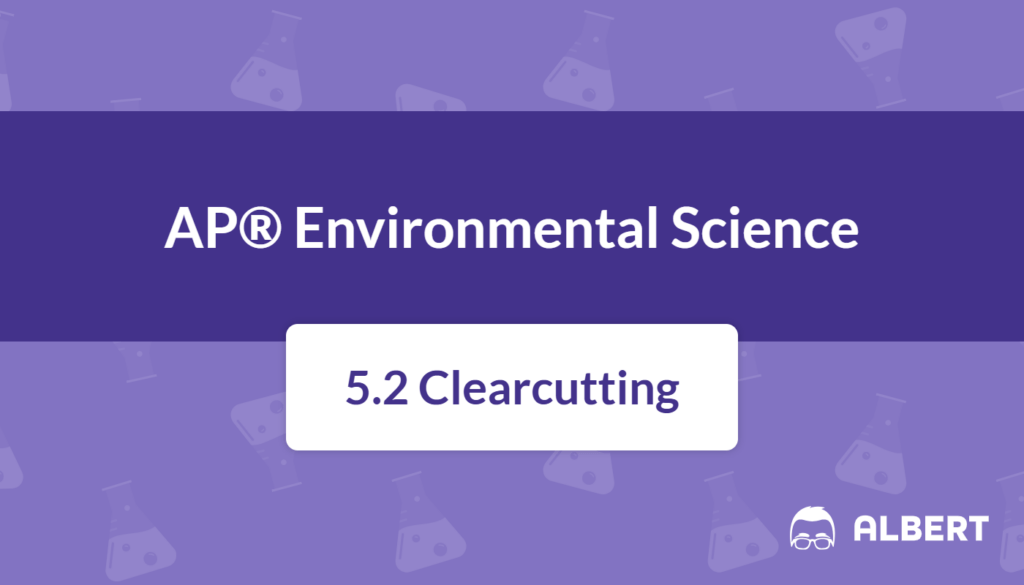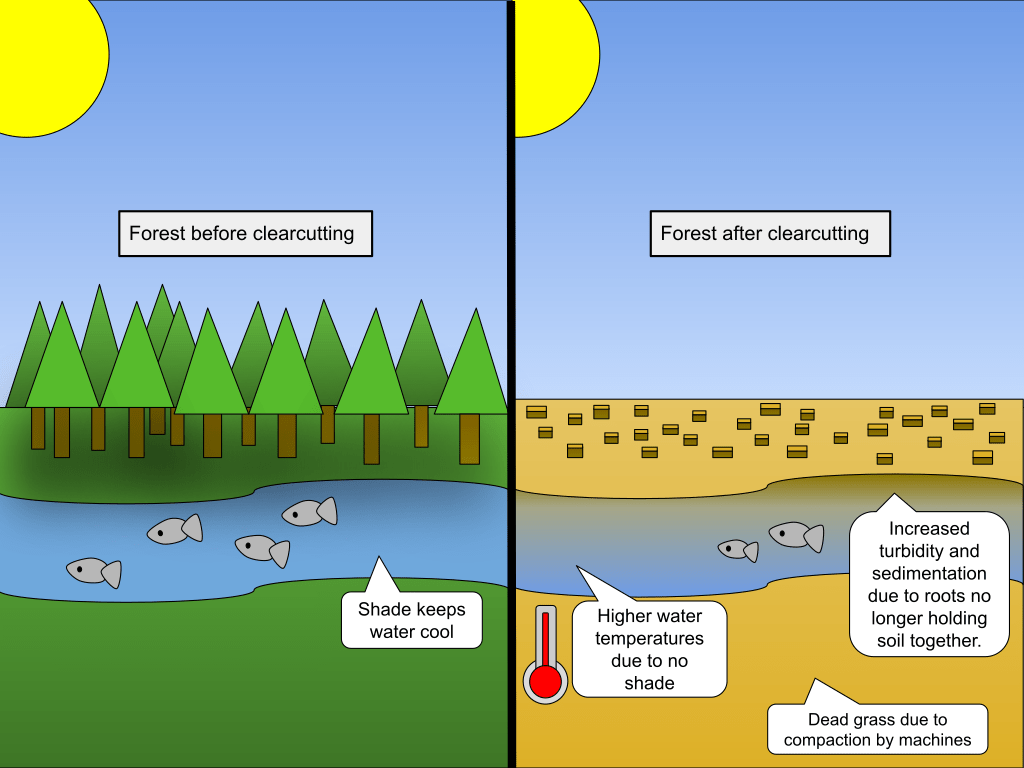What We Review
Introduction
Clearcutting is a forestry practice that removes nearly all trees within a specified area. Although clearcutting can provide short-term economic benefits, it can also lead to long-term environmental consequences, such as soil erosion and habitat disruption. By examining both its advantages and drawbacks, students can better appreciate why sustainable alternatives are crucial for preserving ecosystems. This article explores the definition, key impacts, and possible solutions tied to clearcutting, following the expectations of AP® Environmental Science.
Clearcutting, at its core, is a land-management strategy that involves harvesting large areas of mature trees all at once. Over many decades, timber companies have used this method to meet global wood demand. However, the practice also affects soil, water quality, wildlife, and climate regulation processes. Therefore, understanding the intricacies of clearcutting is essential for students studying environmental science. These impacts go beyond removing trees, potentially leading to significant shifts in local ecosystems and contributing to atmospheric carbon levels.
What Is Clearcutting?
Clearcutting refers to the complete or nearly complete removal of trees from a designated section of the forest. This method typically involves:
- Marking an area where trees have reached a harvestable age.
- Using heavy machinery to fell every tree in that zone, leaving little to no canopy cover.
- Removing logs for processing while leaving behind debris such as branches.
Because this practice eliminates nearly all tree cover, it can change a region’s microclimate, soil structure, and hydrology. After clearcutting, the ground is often exposed to direct sunlight, which raises surface temperatures and influences evaporation rates.
Example: The Process of Clearcutting a Section of Forest
Imagine a 10-hectare plot of conifer forest in the Pacific Northwest. First, forestry personnel examine the area’s tree maturity and density. Next, once the plot meets commercial standards, timber companies dispatch crews with chainsaws and heavy equipment to remove every merchantable tree. Following the operation, most standing vegetation disappears, and the once-shaded forest floor becomes an open landscape of stumps and dried residue. Subsequently, companies transport logs for milling into lumber. This step-by-step procedure demonstrates how swiftly a forest can shift from a mature ecosystem to a cleared tract of land.
Economic Advantages of Clearcutting
Clearcutting remains favored by some timber companies due to several economic advantages:
- Efficiency in Harvest: Removing all trees in one pass can be faster and cheaper than selective logging.
- Uniform Regeneration: Companies often replant a single fast-growing species, reducing labor and costs.
- Boost to Local Economies: Logging operations can create jobs in rural areas, supporting local infrastructure and commerce.
However, economic gains can be offset by the long-term ecological damage that clearcutting may cause. Therefore, while it contributes to higher short-term profit margins, responsible forestry must also account for water quality, wildlife habitats, and ecosystem resilience.
Example: A Clearcutting Project That Boosted Local Industry
Consider a community in the southeastern United States reliant on timber harvests. When a large timber corporation decides to clearcut a 50-hectare parcel, the immediate outcome is an injection of jobs into the area. Truck drivers, machinery operators, and mill workers find employment, and local businesses (from hardware stores to diners) see an uptick in customers. As a result, the regional economy experiences a temporary surge. Nevertheless, maintaining this level of economic benefit over the long haul requires careful management of land resources.
Environmental Effects of Clearcutting
While clearcutting can be profitable, it can also create notable environmental challenges. These include increased soil and stream temperatures, heightened soil erosion, and greater risk of flooding. Consequently, understanding these effects helps students weigh the short-term and long-term outcomes of deforestation decisions.
Soil Erosion
Soil erosion occurs when water or wind removes exposed soil. Tree roots are essential for stabilizing the ground, and a dense canopy helps minimize the direct impact of rainfall. By contrast, clearcutting exposes soil to the full force of precipitation, making it easier for water runoff to carry away the top layer of soil. Topsoil is nutrient-rich, so its loss can drastically reduce the fertility of cleared areas and downstream farmland.
Step-by-Step Example: Transformation of the Landscape
- Before clearcutting, a forest floor is protected by a network of roots and leaf litter.
- Once trees are removed, the soil has fewer anchoring roots and less protective cover.
- Heavy rains wash away surface layers of soil, depositing sediments in nearby streams.
- As erosion continues, the land becomes less capable of supporting new growth, and stream habitats suffer from silt overload.
Hence, clearing large tracts of trees can transform healthy forest floors into eroded hillsides, affecting both terrestrial and aquatic life.
Increased Soil and Stream Temperatures
Forests help regulate temperature by providing shade and transpiration. When tree cover disappears, surface temperatures rise. Moreover, streams and rivers that once flowed through shaded areas now receive direct sunlight. Consequently, aquatic organisms sensitive to temperature changes may struggle to survive. Trout and other cold-water species often experience stress or even extinction in regions subjected to intense clearcutting.
Example: A Clearcutting Scenario and Its Immediate Effects on Water Bodies
Suppose a mountainous region contains a creek home to trout, which require cooler water to thrive. When logging crews remove a significant number of trees along the creek banks, the water is suddenly exposed to more direct sunlight. Within a few weeks, water temperatures climb enough to lower dissolved oxygen levels, which fish depend on for respiration. This chain reaction underscores how deforestation alters ecosystems far beyond the boundaries of the cut area.
Flooding and Habitat Disruption
Without a robust canopy and root system, water infiltration and absorption rates change dramatically. Consequently, rainfall that was once captured by foliage and held in the soil runs off more quickly. Flood peaks can become more intense after clearcutting, raising disaster risks near riverbanks. Additionally, local wildlife loses its primary shelter and food sources, leading to habitat fragmentation.
Example: A Region Experiencing Flooding After Clearcutting
Imagine a tropical rainforest region where heavy downpours are common. Once an expanse of trees is cleared, the exposed soil can no longer handle high volumes of rain. As a result, nearby rivers swell rapidly. Floodwaters damage homes in downstream communities, and wildlife populations suffer from a lack of cover. Through this example, it becomes evident that clearcutting’s impact stretches far beyond a forest stand, influencing broader ecological and social systems.
Clearcutting and Climate Change
Forests play a vital role in mitigating climate change by absorbing pollutants and storing CO_2 (carbon dioxide), a greenhouse gas. Trees remove CO_2 from the atmosphere through photosynthesis and store carbon in their biomass. When forests are clearcut, the stored carbon is often released if the wood is burned or decays rapidly after harvest. Consequently, this release of CO_2 can accelerate global warming.
Example: An Analysis of Carbon Emissions from a Clearcutting Site
Consider a mature forest that stores thousands of tons of carbon in its trunks, branches, and soil. Once a clearcutting operation removes these trees, a portion of the wood is processed into products but ultimately decomposes or is burned. By comparing the carbon emissions pre- and post-harvest, researchers see a sharp increase in CO_2 released into the atmosphere. These emissions can take decades to reabsorb, especially if replanting efforts do not match the original forest’s complexity and density.
Alternatives to Clearcutting
Although clearcutting is efficient, it is not the only approach to forest management. Several alternatives can provide timber without causing extensive environmental damage. These options include:
- Selective Cutting: Harvesting only specific tree species or individual trees to maintain biodiversity and reduce soil disturbance.
- Shelterwood Cutting: Gradually removing mature trees in stages, allowing younger trees to grow under partial canopy cover.
- Reforestation and Restoration: Replanting with native species and supporting natural regeneration processes.
Moreover, sustainable forestry practices aim to strike a balance between economic gain and ecological well-being. By carefully selecting trees to remove and preserving forest structure, these methods can generate timber resources over a longer time without drastically altering ecosystems.
Example: A Successful Forestry Project With Alternatives to Clearcutting
In parts of northern Europe, some forestry cooperatives have shifted to selective cutting. These programs identify only mature or damaged trees, removing them while preserving the understory. Over several decades, the forest retains a dynamic mix of trees at various ages, ensuring habitats for diverse wildlife. Meanwhile, timber production remains steady because the forest regenerates continuously. Consequently, this approach shows that forestry does not have to be an all-or-nothing process.
Conclusion
Clearcutting is a widespread forestry practice that can provide substantial economic returns in the short term. However, its long-term environmental effects are significant, ranging from soil erosion and increased stream temperatures to flooding and habitat fragmentation. Forests also store large amounts of CO_2, and removing them contributes to climate change when carbon is released into the atmosphere. To balance economic interests and ecological integrity, many experts advocate for sustainable forestry approaches such as selective cutting and reforestation. By understanding both the advantages and the drawbacks of clearcutting, AP® Environmental Science students can better evaluate land-use practices and consider how these decisions impact ecosystems far into the future.
Key Vocabulary
- Clearcutting: The complete removal of all or most trees in a given forested area.
- Soil Erosion: The removal of topsoil by wind or water, often accelerated by the loss of vegetative cover.
- Carbon Dioxide (CO_2): A greenhouse gas absorbed by trees through photosynthesis and released when forests are cleared or burned.
- Deforestation: The large-scale removal of forest cover that results in reduced biodiversity and disrupted ecosystems.
- Habitat Disruption: The process by which species’ living areas become altered or destroyed, often through logging or development.
- Sustainable Forestry: Management practices designed to balance timber production with long-term environmental health and biodiversity.
Sharpen Your Skills for AP® Environmental Science
Are you preparing for the AP® Environmental Science test? We’ve got you covered! Try our review articles designed to help you confidently tackle real-world AP® Environmental Science problems. You’ll find everything you need to succeed, from quick tips to detailed strategies. Start exploring now!
- AP® Environmental Science: 4.8 Review
- AP® Environmental Science: 4.9 Review
- AP® Environmental Science: 5.1 Review
Need help preparing for your AP® Environmental Science exam?
Albert has hundreds of AP® Environmental Science practice questions, free response, and full-length practice tests to try out.









